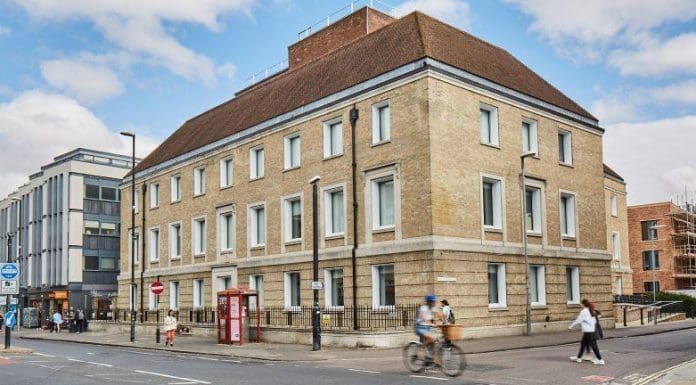
James Cole, chief innovation officer at the Cambridge Institute for Sustainability Leadership (CISL), discusses their new Living Lab programme and its work to make retrofitting more accessible for all
Recently, the Met Office confirmed what we are all increasingly feeling. More very hot days, and fewer cold nights.
Scientists warn that climate change does not only equal more heat, but more disrupted and severe weather events, with implications for loss of life as well as comfort for those of us struggling to sleep in the past few weeks.
To mitigate the worst impacts of climate change, we will need to adapt the vast majority of properties, not only to reduce their greenhouse gas emissions but also to make them resilient and comfortable places to live, work, and play.
Investing in the future
The good news is that this investment should make places better. Better for our health, better for our comfort, and better for our planet. This often gets forgotten in the politicised ‘dash for net zero’, and the lack of effective communications on the benefits of retrofit to people, not just planet.
At the Cambridge Institute for Sustainability Leadership, we have worked with industry and policymakers for over 35 years to advocate and design for effective market solutions – with many notable successes.
So, when we came to re-develop our own headquarters, we had to walk the talk, and prove that leadership, collaboration, and innovation could deliver results – both economically and in sustainability terms.
The result is a 3000 sq m office building which hosts our staff and startups in our ‘Canopy’ incubator, which now uses less than 15 % of the energy it did previously, offers superior air quality and comfort levels, and meets the proposed 2050 net zero energy intensity standard today – all delivered within normal commercial cost parameters.
How did we do it? We optimised the entire design, commissioning, and build process for different outcomes, with implications for industry and contracting structures, ways of working, skills, and capabilities. Not only did we want to meet cost, quality, and time targets, but quality for us meant meeting certain standards that ensured our building would be efficient and resilient in the long term, both in climate and commercial terms.
We achieved BREEAM (Outstanding), Passivhaus Enerphit, and Well (Gold) standards – top ratings for buildings that are very environmentally friendly and energy-efficient, carefully designed to use very little energy, and support people’s health and comfort.
We also set our own standards and decision-making criteria on biobased materials, circularity of materials, the innovations deployed, and modelled whole-life carbon over 100 years.
Is it all perfect? No. Some days it’s too hot or too cold. Some days things don’t work. We’ve had to monitor, learn, and adjust things – including our behaviour and understanding. But as a public benefit organisation and as part of the University of Cambridge, we’re committed to sharing our learnings to influence wider industry practice.
That’s why, with the Crown Estate, we’re setting the building up as a ‘living lab’ for innovation in the built environment. The living lab will allow innovators, academics, and pioneering companies in the built environment to come together to pilot and test new interventions in the design, operation, and use of lived spaces – and to communicate and share the results for public benefit. This is expected to deliver even better outcomes in commercially relevant ways.
From the outset, the Entopia Building project set out to challenge the status quo in building design and delivery. By showcasing in practical terms how delivering better buildings is possible through leadership, collaboration, and innovation, the project set an example for the industry as a whole. The Entopia Building continues to win awards for its approach.
However, we don’t want to be the building that is continuing to win awards in the years to come; we want to be projecting this forward to influence other buildings that can go even further, and help to pioneer new building practices and innovations that will unlock the whole industry step change we need for a sustainable transition.
Demonstrating process to deliver more sustainable buildings
One critical feature of our building is that it has little new technology. We have been able to demonstrate what is possible largely with existing technologies, implemented and integrated in new ways, or at a scale not proven before. As such, much of the innovation that took place was process innovation, and this is a critical element of our living lab.
We want to demonstrate the value of more collaborative approaches to projects – a tenet pioneered by our executive Master’s in Interdisciplinary Design for the Built Environment (SLBE) – and the need to unlock new procurement and design team practices.
For example, one thing we have learnt is that it would have been very helpful to have our interior designer join us earlier in the process. Joining the team to consider the interior late in the project meant there were certain decisions, such as lighting configuration and tea point specification, which were already locked in.
This is the same for the wider team, whilst the cost of earlier engagement can prevent this, cost savings can be made if collective decision-making – including user representatives – occurs earlier in a process, resulting in fewer delays and a lower need to change plans or modify existing structures and setups at a later date. Likewise, thinking about how we use incentives and procure services is an important area to explore.
We identified nine key ways Entopia can build change through proving that:
- Sustainability targets improve performance.
- Refurbishment can be cost-competitive.
- Taking a ‘fabric first’ approach cuts costs and energy.
- Circularity principles reduce embodied carbon.
- Whole life design is critical to informing decision-making and ROI planning.
- Open communication improves outcomes.
- A sustainability representative at each stage was critical to retaining focus.
- Carbon and energy-saving measures can sway planning decisions.
- Post-handover assessments are critical to fine-tune and review theory vs practice.
We have had so much interest in the Entopia building and our lessons since opening in 2022 that we haven’t been able to keep up with demand. We are keen to demonstrate these nine areas, and others, across other projects.
Delivering data and evidence for sustainable practices
We know there is an appetite to change, but a lack of data and proven cases to support action, particularly in commercial buildings. In launching Entopia as a Living Lab, we are opening up the building and our Living Lab members’ own buildings to share and co-create these open-source points of evidence and build momentum for scaled-up action.
Buildings are designed from plans which make assumptions about how they will perform once built and lived in – from their comfort, to their energy use, to their climate resilience. Many of the smart technologies that are coming to market allow us to better manage our buildings and more dynamically predict and understand how they perform to meet our needs. This is useful for people who live and operate them, as they can more dynamically adjust comfort and heating levels, for example, and save energy and costs. However, this data often remains proprietary to the building users or managers only. The data available from these systems would also be useful for architects, policymakers, insurers, and others who make decisions about properties and their design and use, and need to validate assumptions on cost, risk, and performance.
Through the Living Lab, we will be pooling this data and insights from these different systems and parties to understand exactly how things are working in practice. We can test design assumptions and share the knowledge of what works best – reducing risk for everyone and improving how we approach projects in the future, benefiting all stakeholders, including property owners, managers, and occupiers, by removing the guesswork.
Engaging beyond traditional project boundaries
The Entopia Living Lab is more than a building – it’s a living, breathing network and an ecosystem for change. Whilst the Entopia Building is a single building, what CISL has developed is a hub of innovation for sustainable futures, both powered by CISL’s own activities and its Canopy community.
The Living Lab takes this spirit beyond our walls, weaving this community and activity into the fabric of society through our built places. Through our members, we are creating a network of places and spaces that deliver tangible benefits for people and planet. So often projects stop at the red lines of a masterplan. But real sustainability means extending beyond these boundaries. If we want our built environment to truly make a difference – cutting carbon, boosting biodiversity, and improving lives – our influence must reach further. That takes collaboration and cooperation. It takes shared commitment to change.
By taking a networked approach, CISL is building a place-based community that helps unlock wider benefits and demonstrates with real evidence what is possible when we take a more holistic and outcome-oriented view of the places we’re responsible for.
What we can do with the Living Lab
We’ve a big ambition for our Living Lab and have set out some key areas of focus above.
Overall, it will be a platform for:
- Experiments and validation pilots towards a sustainable built environment
- Collaboration, learning, and capacity building across disciplines and value chains
- Supporting the evidence base for ambitious retrofit practices, policies, and technologies
- Informing new standards and protocols for open data sharing and collaboration
- External communication and engagement with policymakers, industry, and professional bodies.
Members of the Lab will have opportunities to:
- Collaborate and learn from CISL, academics, peers, and innovators
- The use of Entopia data to test and validate solutions in the real world
- Contribute to the evidence base, access data, and validate solutions for practice and academic applications
Join the Entopia Living Lab and help drive a more sustainable built environment
Access to the Entopia Building and CISL’s network of senior sustainability decision makers and cutting-edge global innovators, as well as the tools and data that support the Entopia Building to deliver to its ambitious sustainability standards, is provided to members in a variety of ways:
Knowledge and dissemination
Work with us to create a partnership in kind proposal that revolves around knowledge sharing to and from our community.
Data/facilities access
Access our database of built environment datasets for your project. Continually refreshed from both live projects, as well as synthetically-generated data models.
Innovation pilots
For industry partners looking at flexible real estate environments to pilot their solutions and integrate with our digital twin. Includes the creation of a branded case study.
Living Lab as a service
Complement your existing construction project or building with a full bespoke technology specification built on open-API standards and a post-build operational plan to enable innovation communities to connect to your sustainable building.
The post Living Labs prove innovation is driving retrofit resilience appeared first on Planning, Building & Construction Today.

